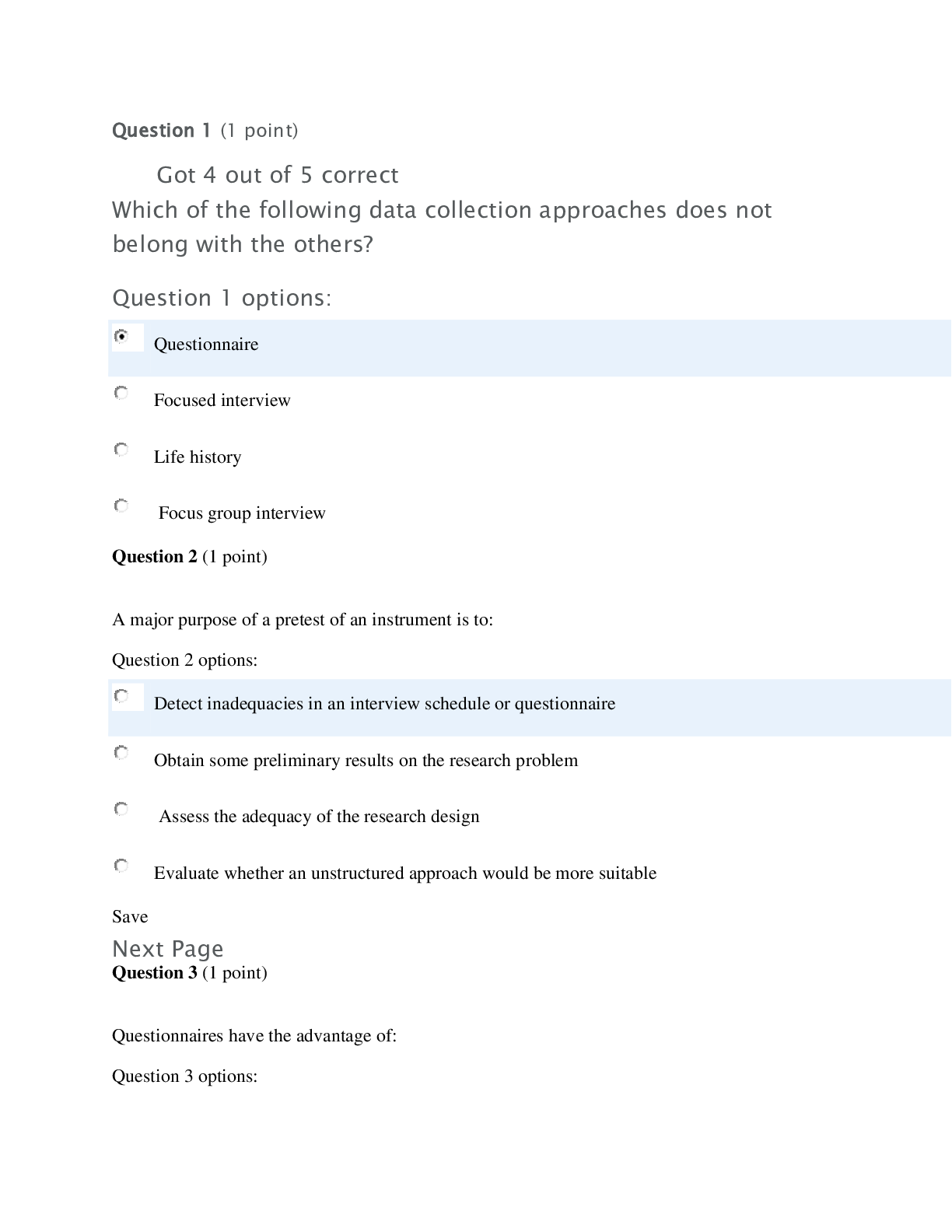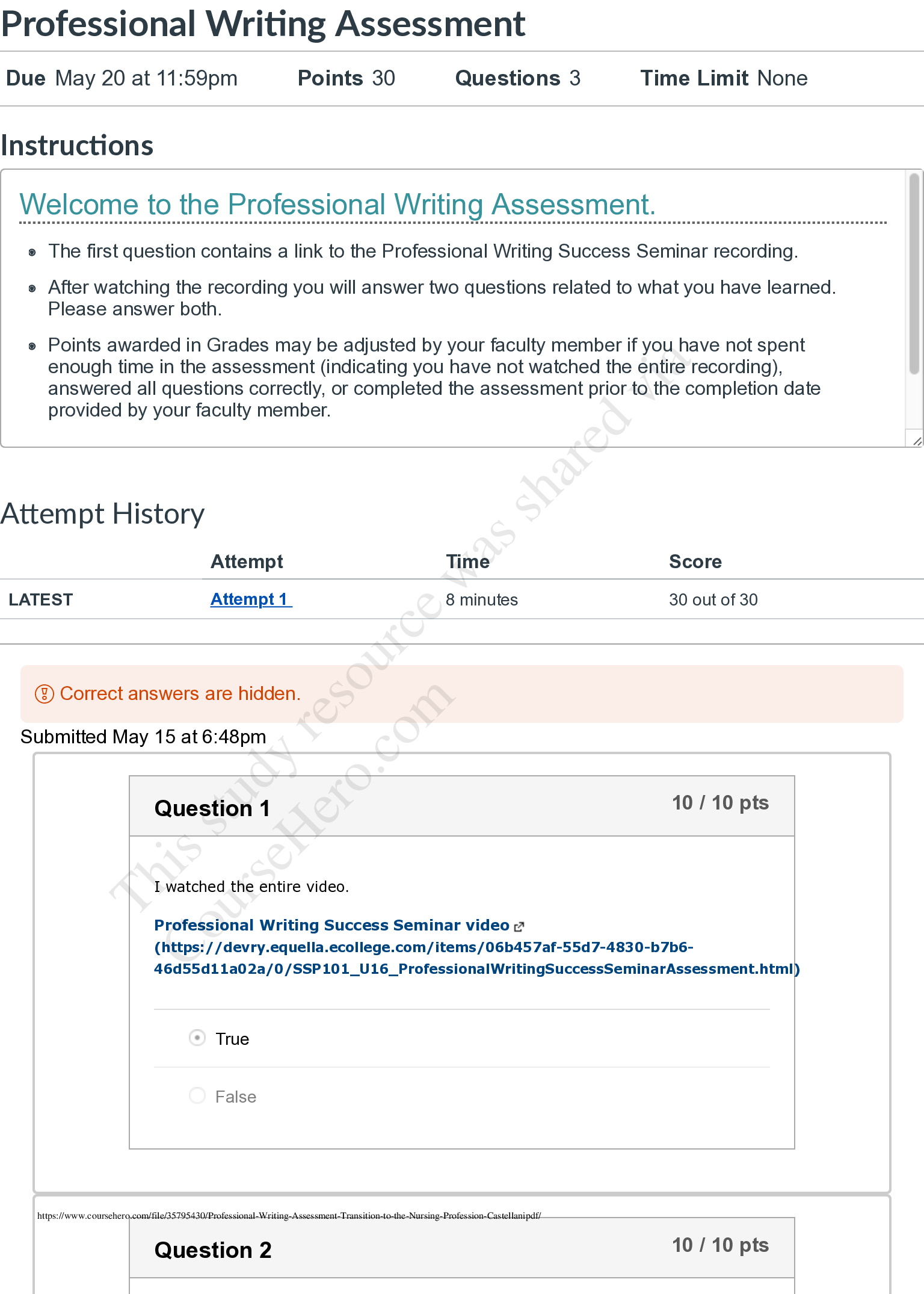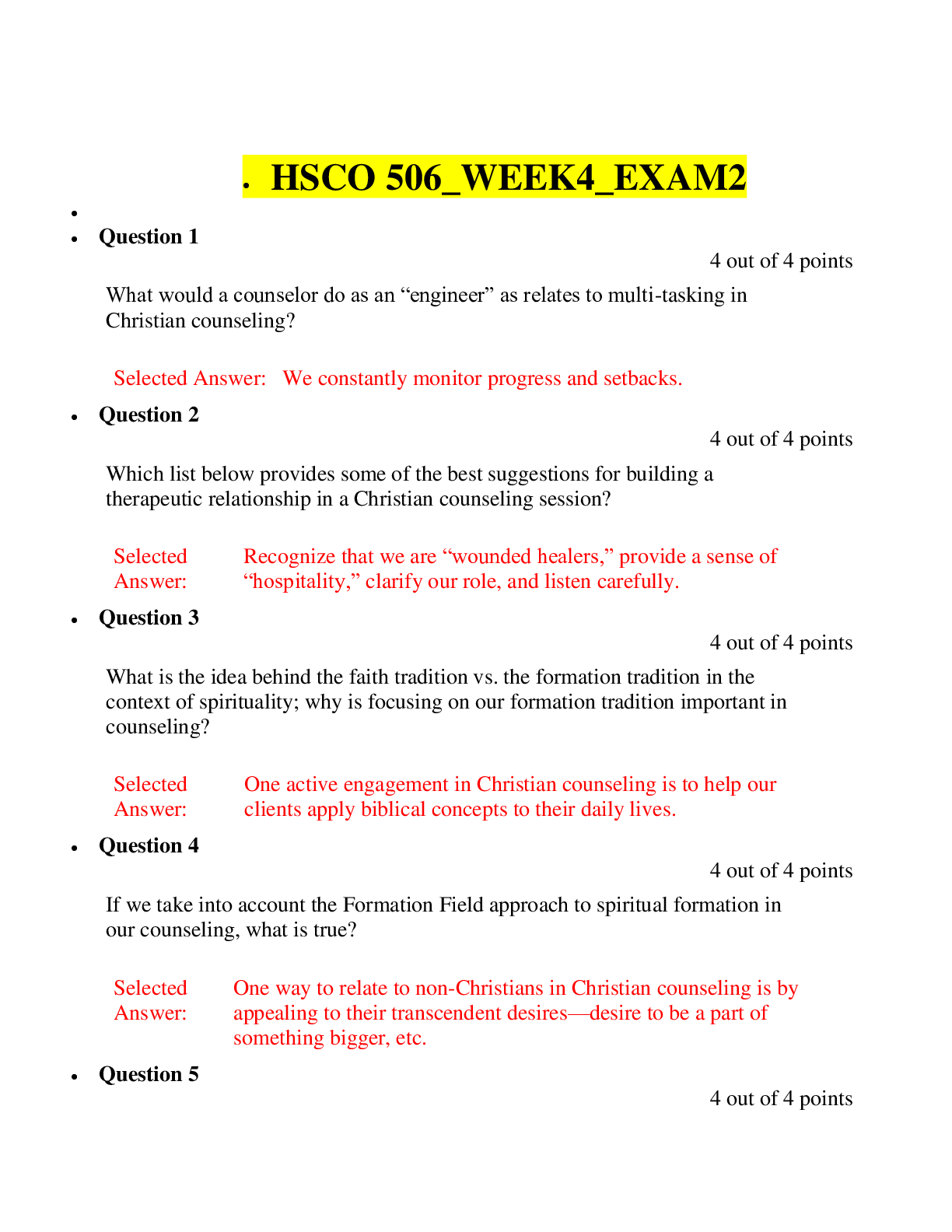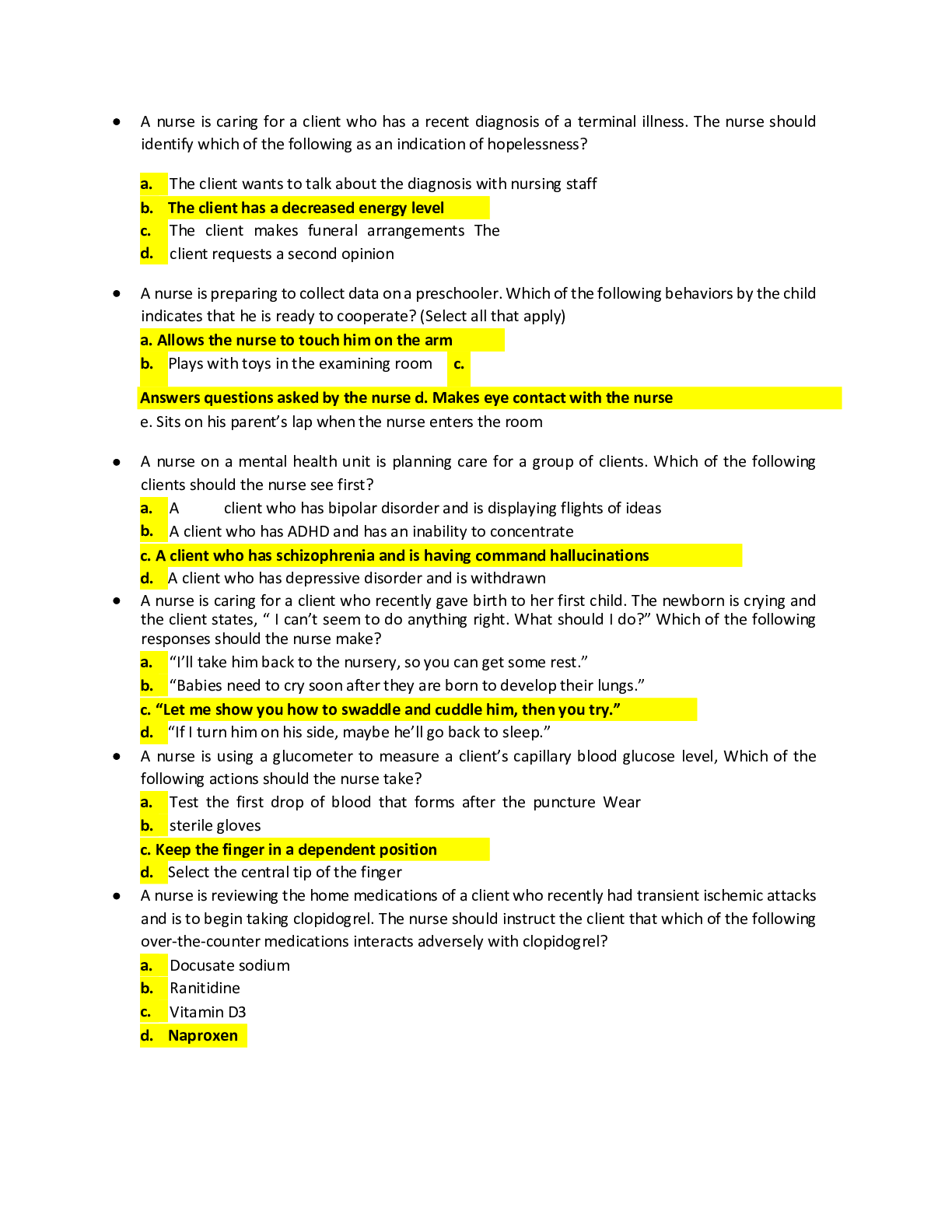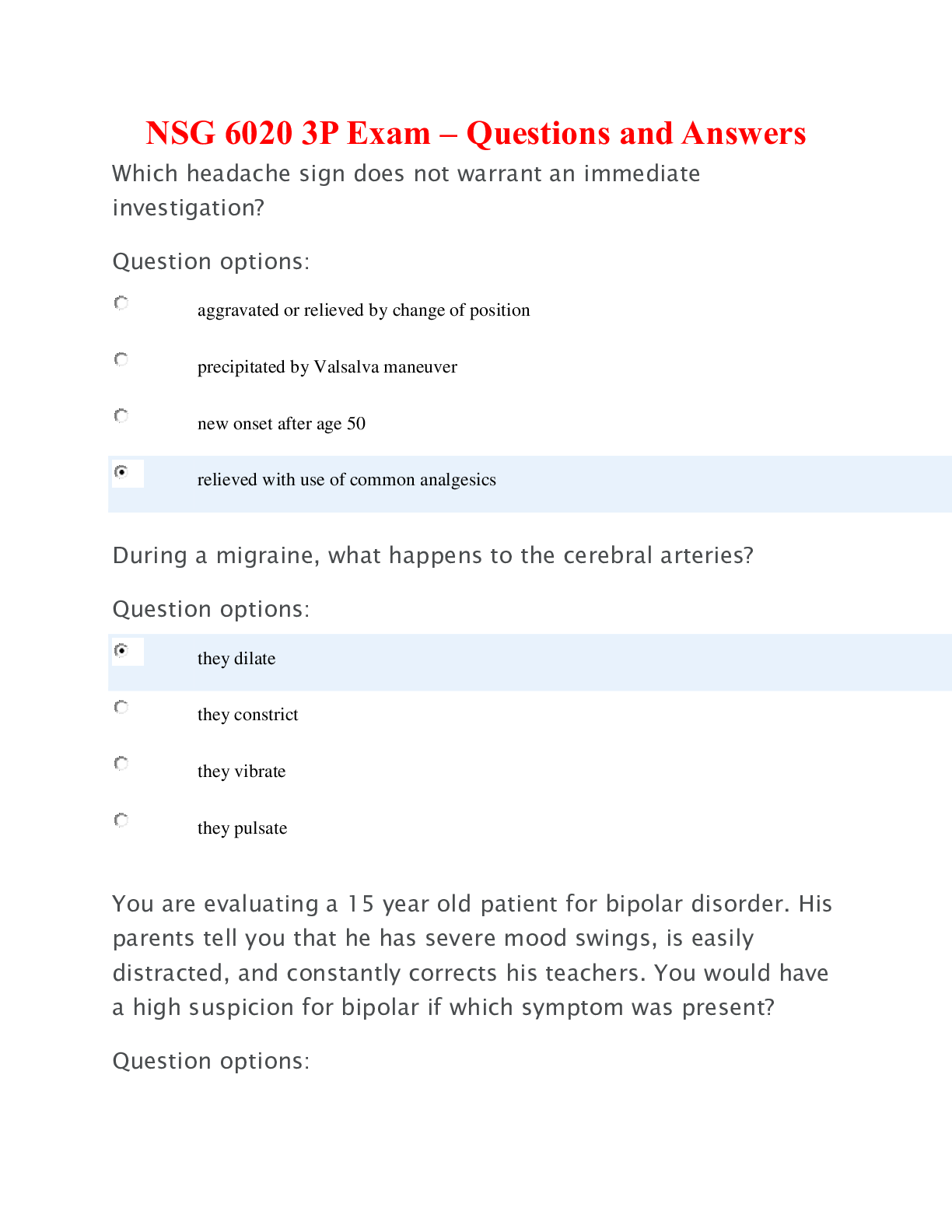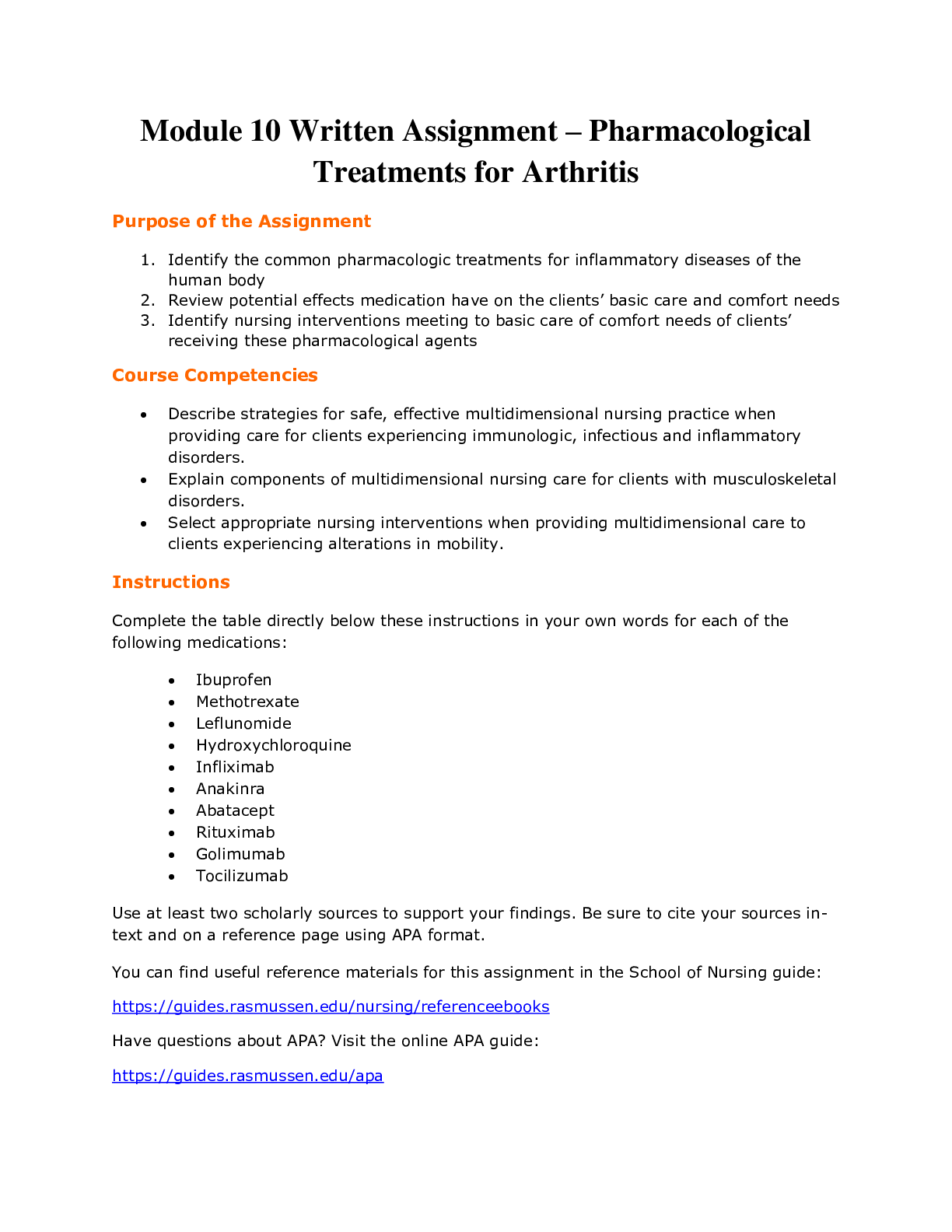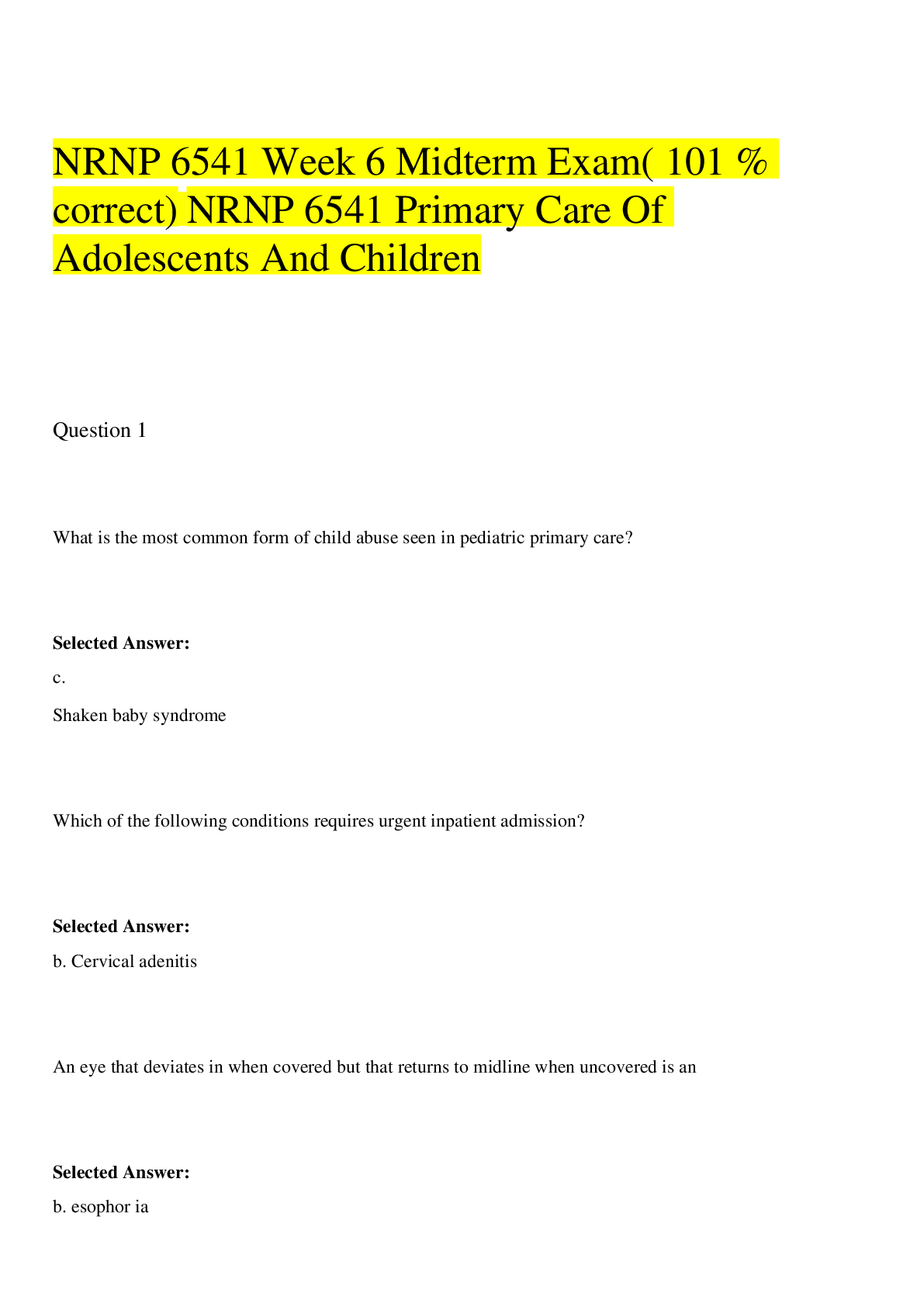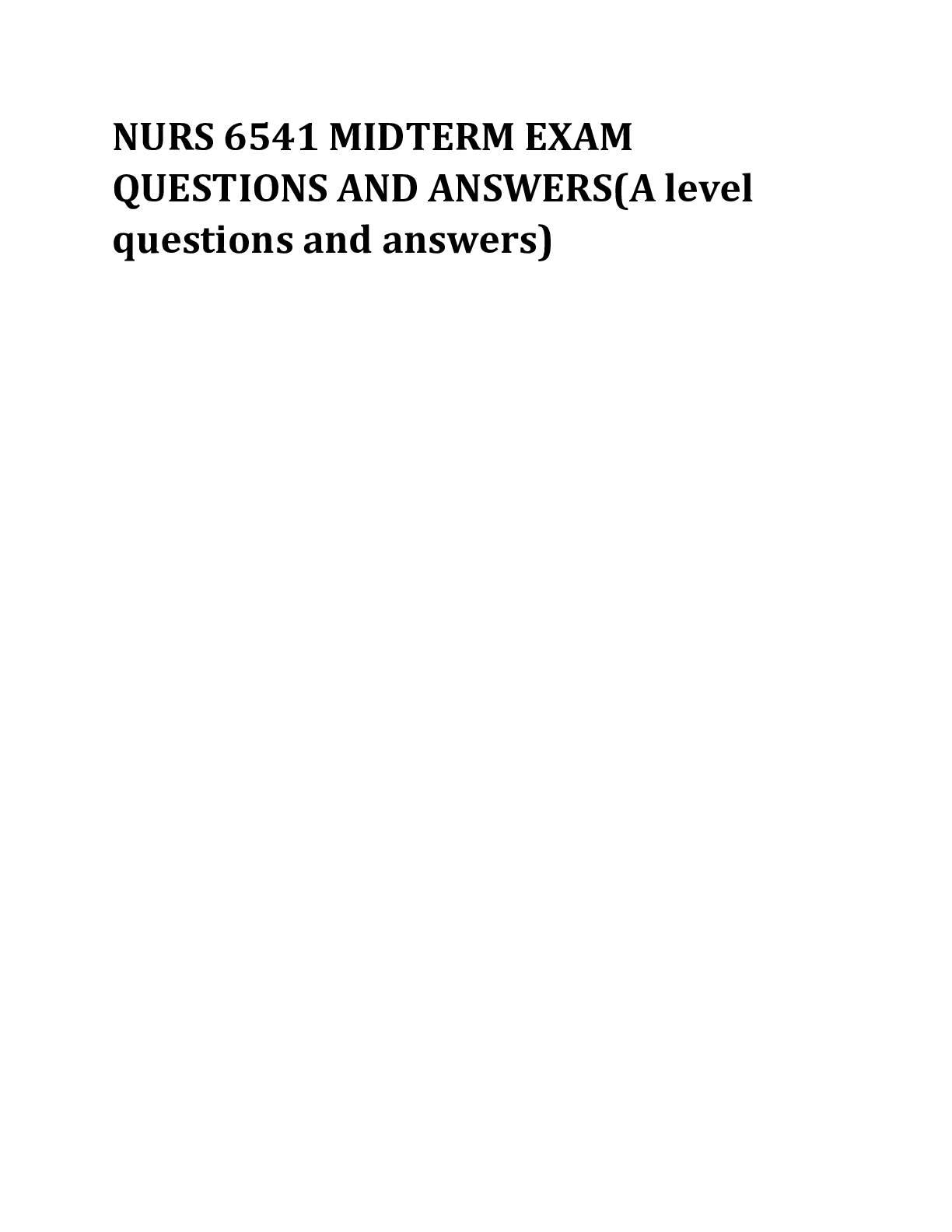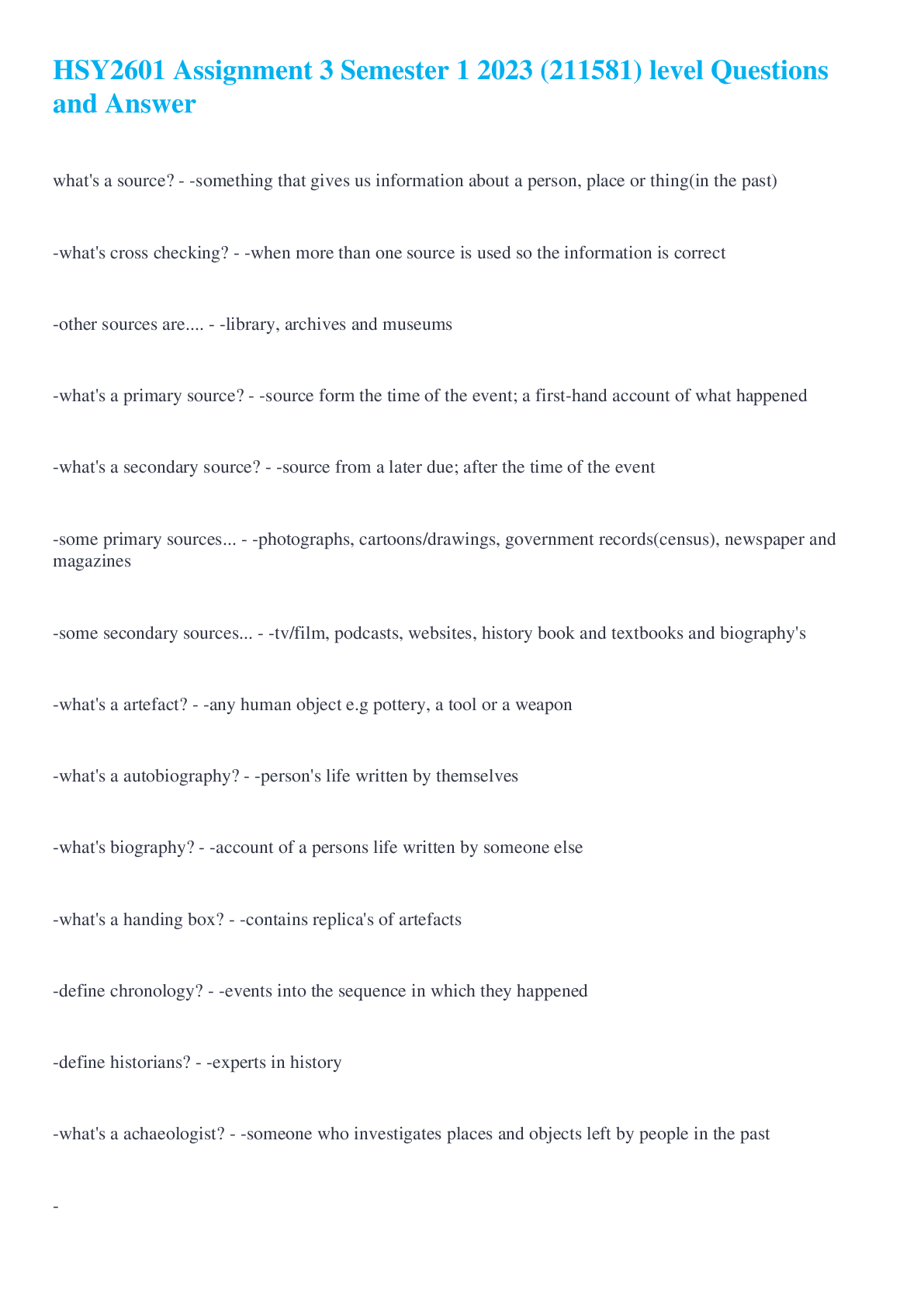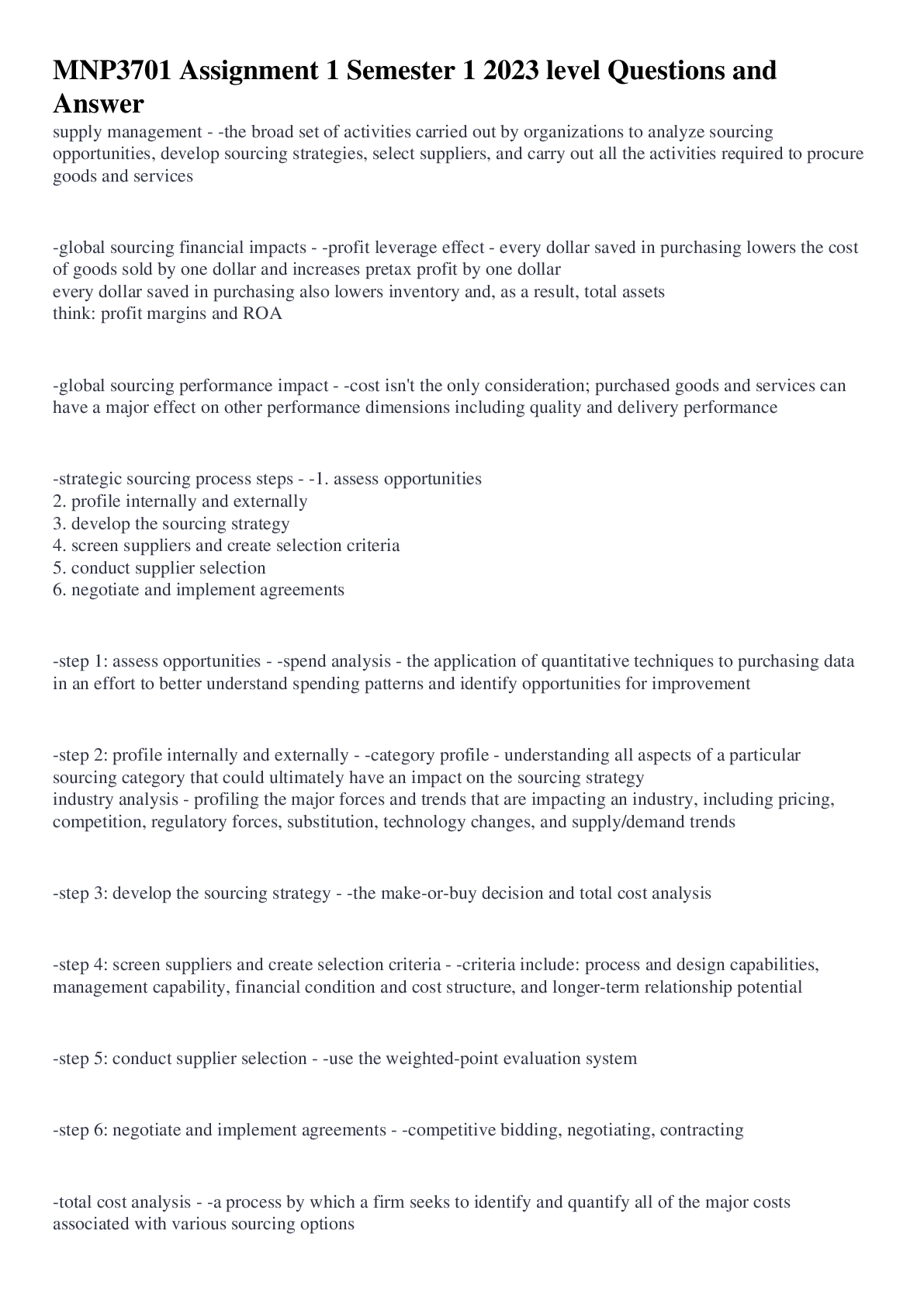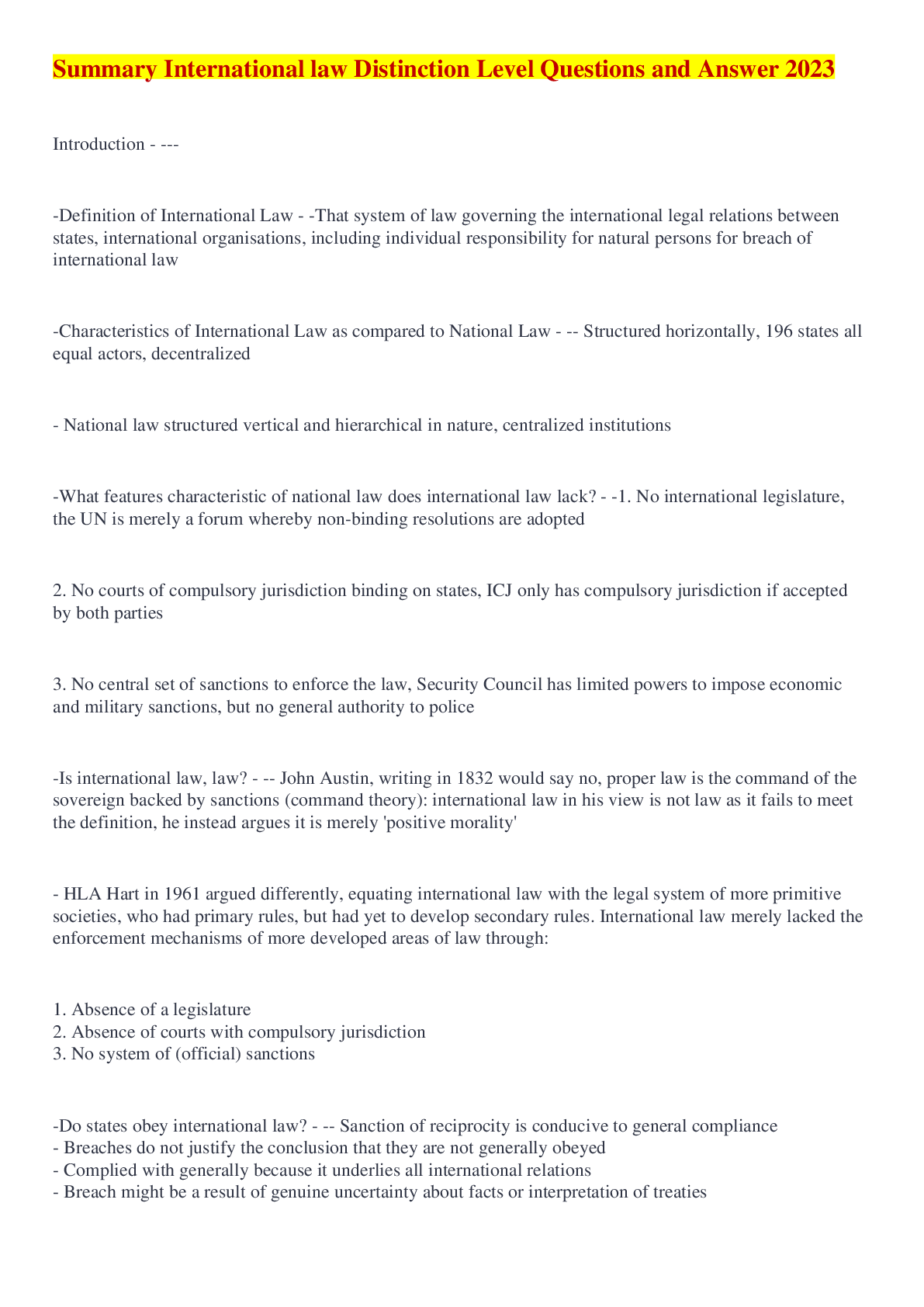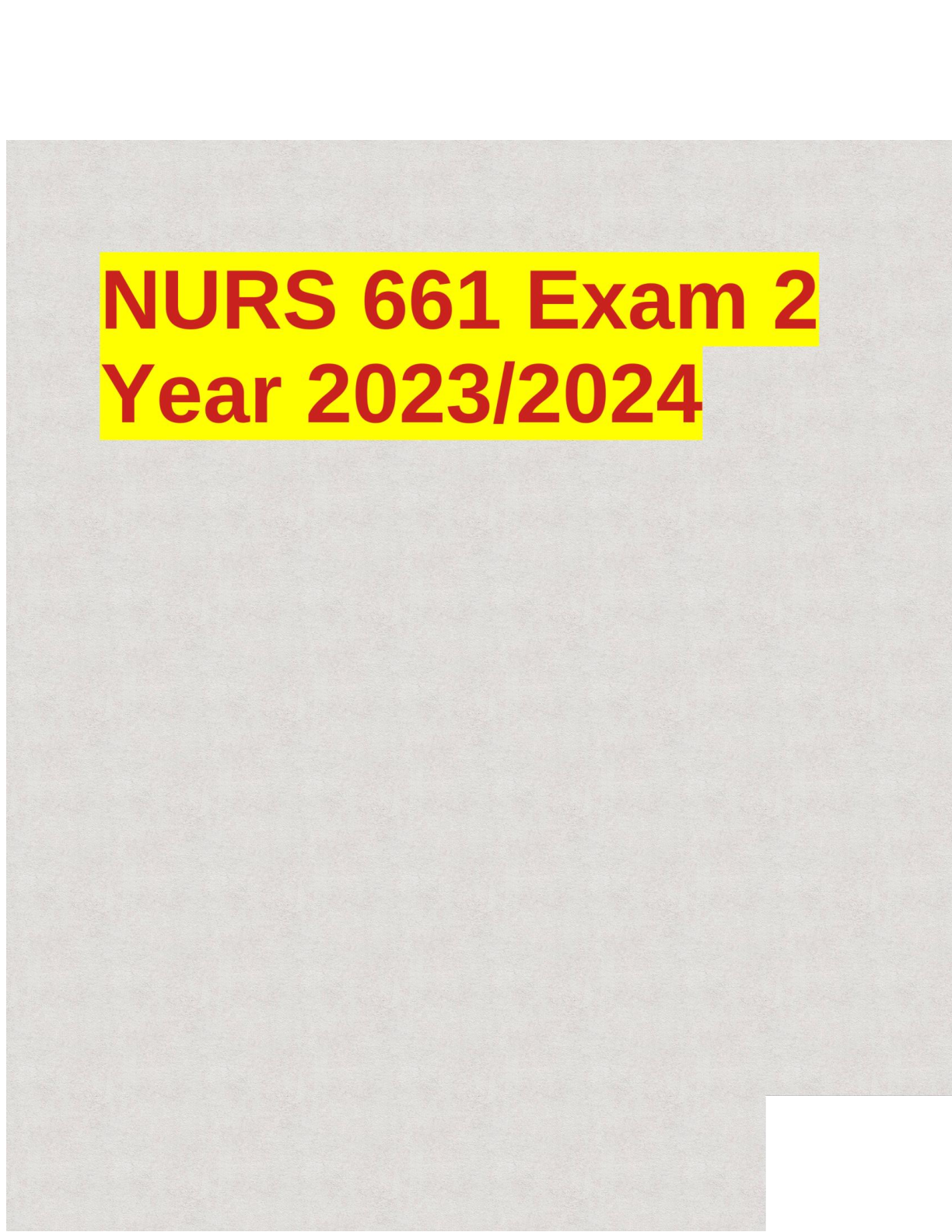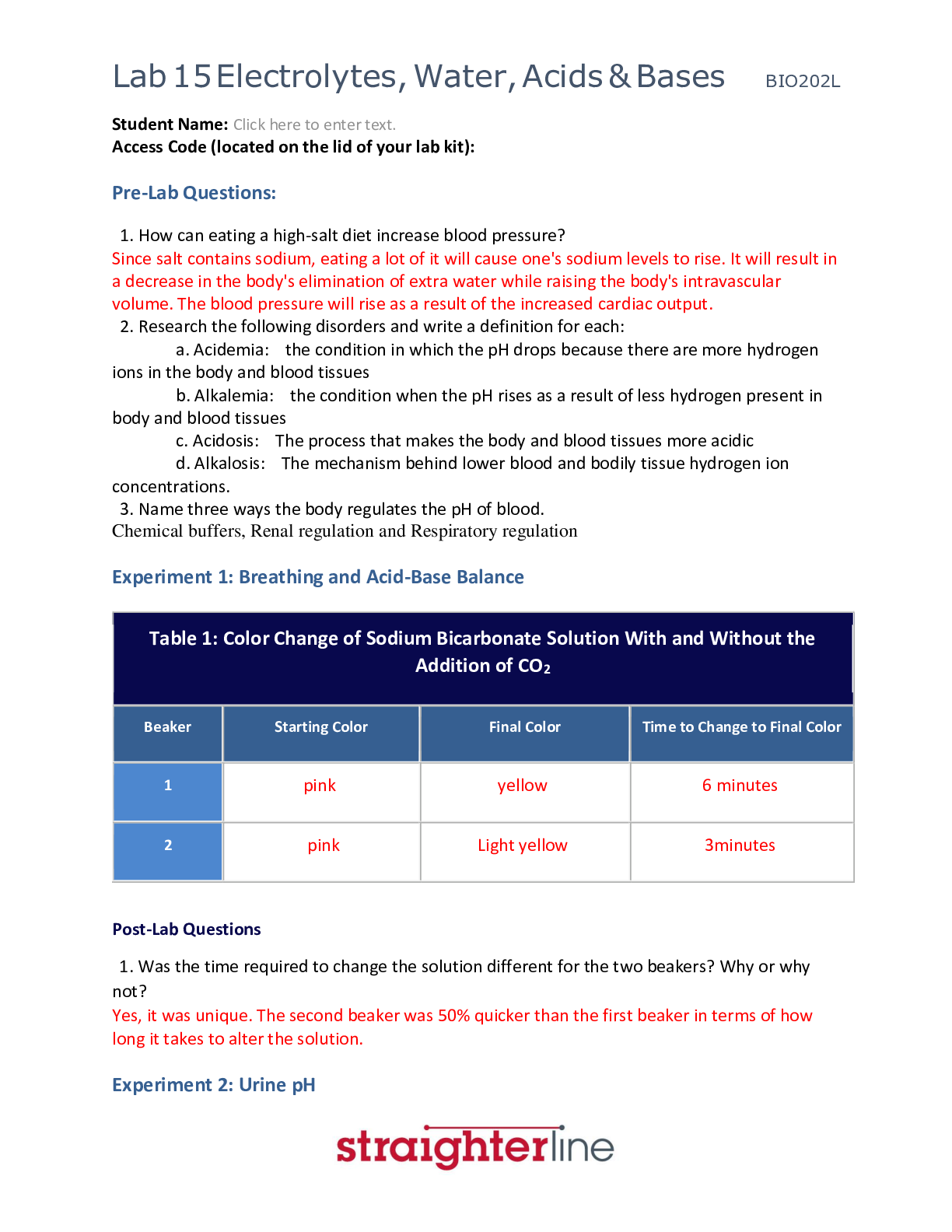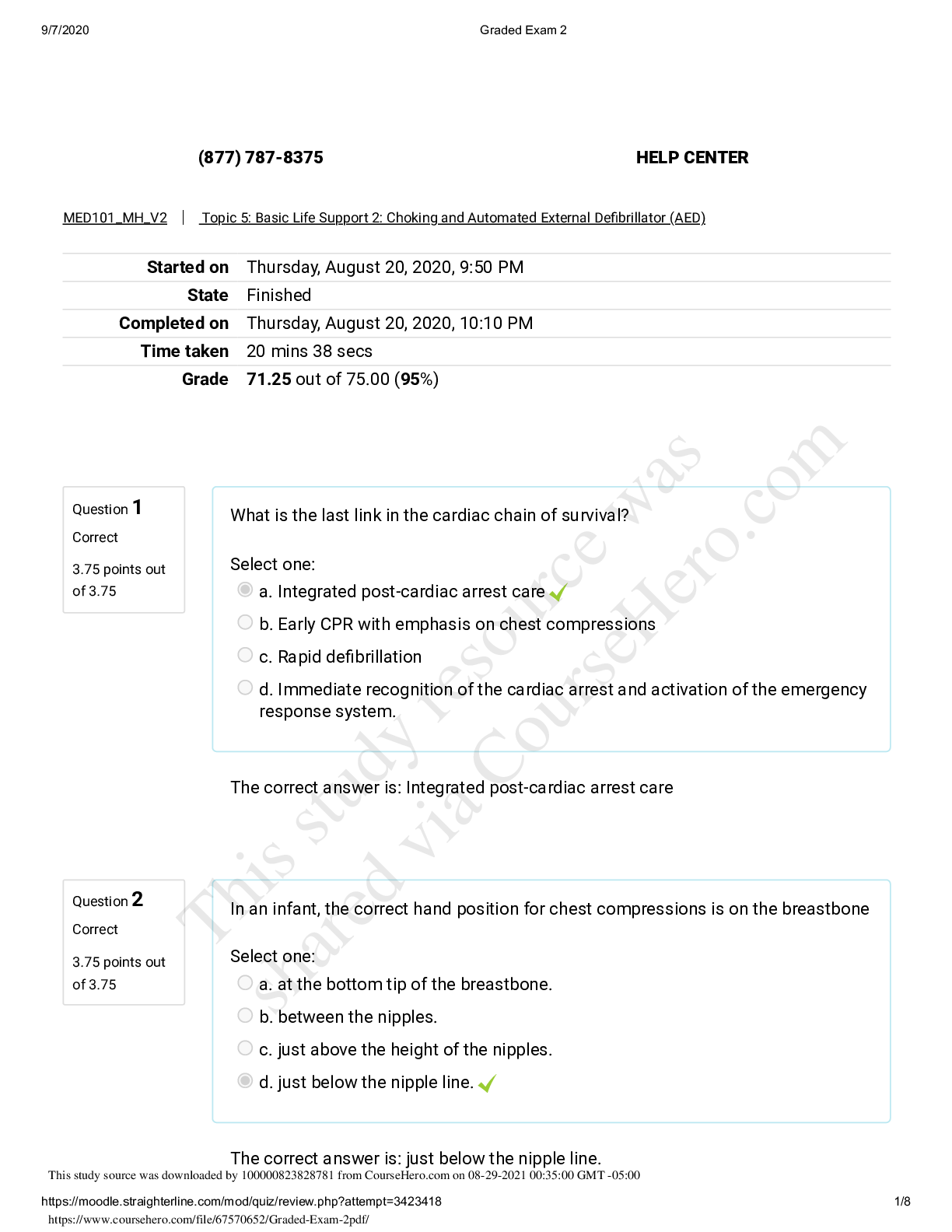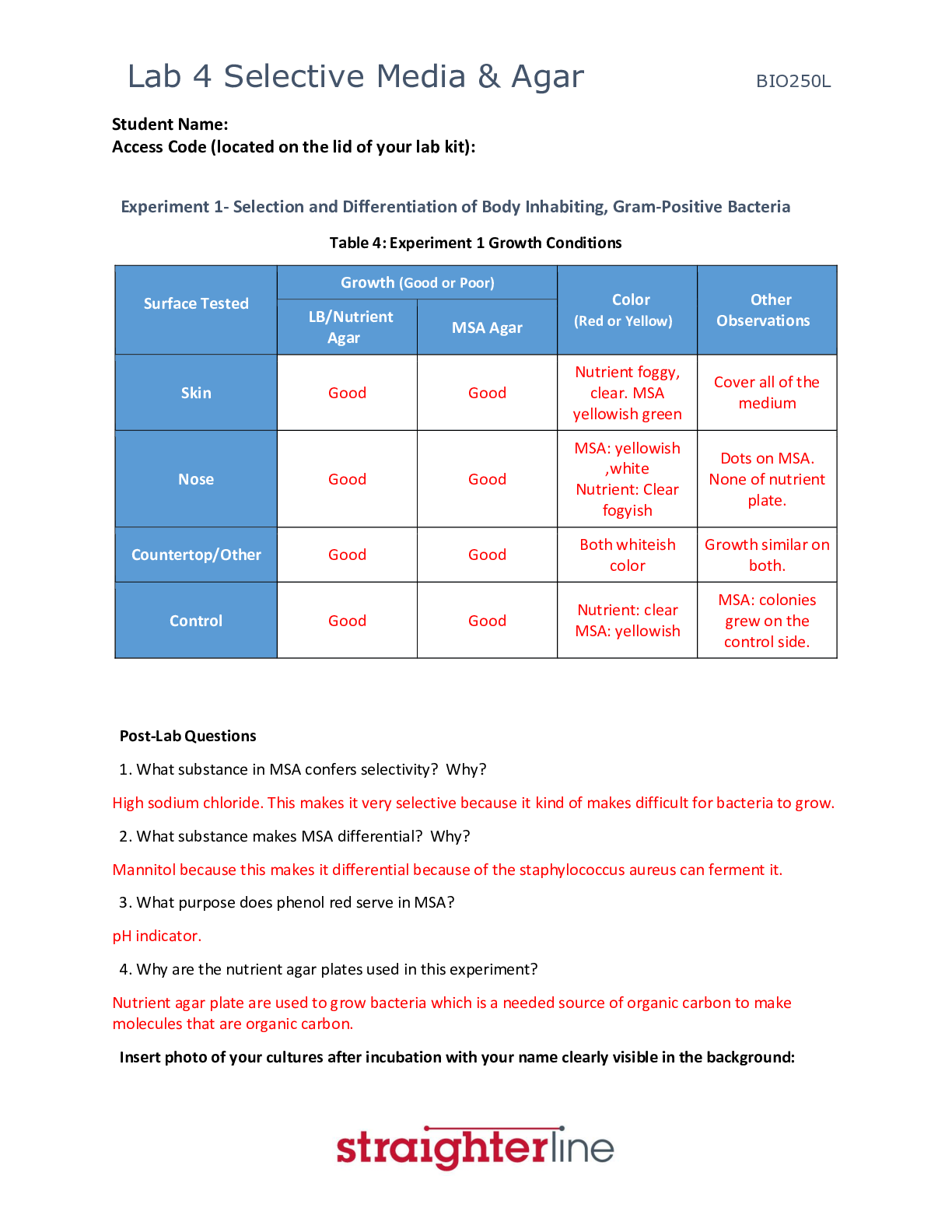BCAT Exam Latest 2022 DISTINCTION level Questions and Answers, Fall 2022
Document Content and Description Below
BCAT exam latest 2022 distinction level questions and answers, Fall 2022. BCAT Exam test questions & Answers. Autism is a: A. Neurodevelopment Disorder B. Mood Disorder C. Metabolic Disorder ASD is c... haracterized by: A. "Difficulties with reading, writing and math" B. "Difficulties in social interaction, communication and repetitive behaviors" C. "Difficulties with communication, acting out and academics" D. "Difficulties with following instructions and self harming" ABA is the cure for autism A. TRUE B. FALSE The three term contingency is A. Antecedent-Behavior-Consequence B. Lions-Tigers-Bears C. Environmental Event-Behavior-Consequence D. Antecedent-Behavior-Reward Behavior must: A. Occur outside of the person B. Be observable by another person C. Be defined as good or bad D. A and B We seek to understand how ________ influence the occurrence of behavior A. Everything B. Private Events C. Environmental events D. Rewards Which is not an area we would work on with our clients? A. Hitting classmates B. Communication C. Feeling Angry D. Difficulties with social interaction Frequency is: A. The length of time it takes to START a behavior after the instruction is given B. Assigning numbers to different prompt levels C. The number of times the behavior occurs D. The length of time that a behavior occurs ABC Data A. "Records the antecedent, behavior and consequence of problem behaviors" B. Is when target behaviors occur C. The length of time a behavior occurs D. The ratio of number of times a behavior occurs per unit of time Whole-Interval Time Sampling A. "Records the antecedent, behavior and consequence of problem behaviors" B. The target behavior is recorded as a (+) if occurs throughout the entire interval C. The length of time a behavior occurs D. The length of time it takes to START a behavior Rate A. The behavior is recorded as a (+) if occurs at least once at any point during the interval B. The number of times the behavior occurs C. Assigns numbers to different prompt levels D. The ratio of number of times a behavior occurs per unit of time Percent A. Count of Behavior/number of opportunities X 100 B. The ratio of number of times a behavior occurs per unit of time C. The number of times the behavior occurs D. The length of time that a behavior occurs Scatterplot A. The length of time a behavior occurs B. The number of times the behavior occurs C. When the target behavior occurs D. The behavior is recorded as a (+) if occurs at least once at any point during the interval Duration A. The ratio of number of times a behavior occurs per unit of time B. The length of time it takes to START a behavior after the instruction is given" C. The number of times the behavior occurs D. The length of time a behavior occurs Prompt Level A. When the target behavior occurs B. Assigning numbers to different prompt levels C. Count of Behavior/number of opportunities X 100 D. "Records the antecedent, behavior and consequence of problem behaviors" Partial Interval Time Sampling A. The behavior is recorded as a (+) if occurs at least once at any point during the interval B. The target behavior is recorded as a (+) if occurs throughout the entire interval C. The time it takes to START a behavior after the instruction is given D. The number of times a behavior occurs Latency A. The length of time that a behavior occurs B. When the behavior occurs C. The length of time it takes to START a behavior after the instruction is given D. Count of behavior/number of opportunities X100 Positive reinforcement is when you add a stimulus to the environment to increase the future frequency of that behavior. A. TRUE B. FALSE Low effort responses should receive the most powerful reinforcers. A. TRUE B. FALSE Positive reinforcement should be delivered: A. Immediately after the desired behavior B. at the end of the session C. After you record the data The following is an example of an unconditioned reinforcer: A. TV B. Food C. Iphone D. Bubbles Erica correctly answered 10 math problems. What is an example of a behavior specific praise statement? A. "Good job" B. "All done" C. "Great work on your math problems, Erica" D. "Erica, awesome!" What is the best way to determine what items to use as a reinforcer during the session? A. Ask the parents B. Give them M & Ms because you know they like them C. Use whatever toys are in your bag D. Conduct a preference assessment A conditioned reinforcer is a reinforcer that is not learned A. TRUE B. FALSE Negative reinforcement is the same thing as punishment A. True B. False Scratching a bug bite is an example of negative reinforcement A. True B. False Yelling "no talking" to a group of noisy students is an example of negative reinforcement. A. True B. False You should use intermittent reinforcement when teaching a new skill. A. True B. False Pressing 'start' on the microwave and the microwave beginning is on what type of schedule of reinforcement? A. continuous reinforcement B. intermittent reinforcement A schedule of reinforcement tells you: A. When to deliver a reinforcement B. What reinforcer to deliver What produces a post-reinforcement pause? A. FI B. VI C. FR D. VR & C Delivery of reinforcement after every 5 baskets made during a game is an example of what type of schedule of reinforcement? A. FI B. VI C. FR D. VR Checking your email throughout the day is maintained by what schedule of reinforcement? A. FI B. VI C. FR D. VR Variable schedules of reinforcement produce steady rates of responding A. TRUE B. FALSE Tokens can be exchanged for: A. candy B. toys C. breaks D. all of the above Tokens should be delivered immediately after the desired behavior A. TRUE B. FALSE Providing tokens for the first correct response after 12 minutes is on what schedule of reinforcement? A. FI 12 B. VI 12 C. FR 12 D. VR 12 During extinction, a previously reinforced behavior is no longer followed by a reinforcer, and the behavior____________ in the future. A. decreases B. increases C. stays the same During an extinction burst, the behavior may temporarily increase in ____________, ______________, or _____________. A. frequency, duration or intensity B. "rate, length, force" C. "frequency, rate, duration" D. all the above _______________ is when a previously extinguished behavior occurs again in the future. A. Impromptu recovery B. Voluntary recovery C. Spontaneous recovery D. Impulsive recovery A behavior will decrease more quickly after continuous reinforcement rather than intermittent reinforcement A. TRUE B. FALSE In extinction of a positively reinforced behavior, the ______________ is no longer delivered after the behavior. A. reinforcer B. baseline C. dependent variable D. antecedent When using differential reinforcement to reduce problem behavior, the clinician provides _________ for appropriate behavior and __________ for problem behavior. A. "reinforcement; punishment" B. "punishment; withholds reinforcement (extinction)" C. "reinforcement; reprimands" D. reinforcement; withholds reinforcement (extinction)" If you are using a differential reinforcement procedure, you are using extinction. This means you ignore the client when they engage in problem behavior as long as the behavior does not escalate to a crisis behavior (continuos severe aggression, property destruction, self injurious behavior) A. TRUE B. FALSE Your client often engages in aggression when you place a demand on him (e.g., tell him to sit at the table, clean up, etc.). The behavior intervention plan includes a DRA and provides instructions on how to reinforce compliance (e.g., when he does sit down or clean up, give him access to a favorite toy). What is missing? A. Description of a punishment procedure B. Instructions on what the parents should do C. Description of an extinction procedure D. Description of reinforcement procedure What are the essential components of a skill acquisition program: A. Target Goal B. Data Collection Method C. Teaching procedures D. All of the above Which teaching procedure is therapist directed, structured, and uses contrived reinforcers? A. Natural environment teaching B. Discrete Trial Training C. Shaping D. Differential reinforcement What teaching procedure uses the ABC contingency to teach goals? A. Natural environment teaching B. Discrete Trial Training C. No-No Prompting D. Both A and B RBT's can deviate from the plan or design their own interventions. A. TRUE B. FALSE The most effective interventions combine both NET and DTT A. TRUE B. FALSE Stimulus control is when a response is more likely to occur in the presence of a certain stimulus A. TRUE B. FALSE You put three pictures on the table in front of your client: a car, a block, and a dog. Then, you say "Point to dog." If your client points to the dog you say "YAY!" and give them a preferred toy. If they point to the car or the block, you do not say anything and move on to another trial. This lesson (delivering reinforcement for the correct response, no reinforcement for incorrect response) will result in: A. Stimulus fading B. Stimulus control C. Response control D. Response analysis When Julie sees her friend Carlos, she says "Carlos!" and Carlos looks at Julie and says "Hi, Julie!" When Julie sees her friend Tina, she says "Carlos!" and Tina does not look at Julie or say hi. These consequences will eventually lead to Julie only saying "Carlos" when Carlos is present, meaning her response of saying "Carlos" is now under stimulus control. A. TRUE B. FALSE Which of the following factors is NOT involved in discrimination training? A. Client Response B. Punishment C. Reinforcement D. Discriminative Stimulus During discrimination training, the RBT provides reinforcement when: A. "The picture of the car is present when the client says "car"" B. "The picture of the bike is present when the client says "car"" C. "The picture of the bike is present when the client says "bike"" D. Both A and C You are teaching a client to respond correctly to the instruction "sit down." On your first trial you say "sit down" and the client begins running around the room. What consequence should you provide? A. Give him a high five B. "Say "great job" and move on" C. Say nothing and move on D. "Say "that's bad" and tell his parents?" A prompt is a response the client makes before making the correct response to a question. A. TRUE B. FALSE Which of the following is NOT a type of prompt? A. Gesture B. Physical C. Imitation D. Model What is most-to-least prompting? A. Presenting a stimulus the most amount of times to the least amount B. Letting the client make the most amount of errors to the least amount of errors C. Beginning with the least intrusive prompt and working up to the most intrusive prompt D. Beginning with the most intrusive prompt and working up to the least intrusive prompt Prompt dependency is always the client's fault because they know being is easier than responding correctly A. TRUE B. FALSE Which of the following is NOT a way to prevent prompt dependency? A. Fade prompts as quickly as possible B. Mix new targets and mastered targets C. Ask client if they are ready for the prompt to be faded D. Use the correct prompt type Which of the following is NOT an example of a skill taught via task analysis? A. Washing Hands B. Tying Shoes C. "Saying "Car"" D. Preparing a meal About how many steps make up a task analysis? A. 3 B. 6 C. 10 D. It depends on the client and skills being taught Kathy is teaching her client how to put on a jacket. First, she teaches her client to pick up the jacket. After the client completes this step independently, she teaches him to put one arm through a sleeve. After he is doing that independently, she teaches him to put the second arm through and so on. What chaining procedure is Kathy using? A. Forward Chaining B. Backward Chaining C. Total Task D. None of the Above The following chaining procedure is used most often because the client learns the step closest to reinforcement first. A. Forward Chaining B. Backward Chaining C. Total Task D. None of the Above Jack is working with a client on getting dressed. The client often stops halfway through the task or completes step out of order. What visual may be helpful for Jack's client? A. First, then Board B. Choice Board C. Task Analysis Visual D. Picture Activity Schedule While Samantha was working with a client, she said "wait" and then put a timer on the table in view of the client. Why might Samantha have done this? A. The client is in time out B. Samantha is taking duration data C. The timer is a visual aid for the client D. None of the Above What is generalization? A. A general description of a clients skills B. The ability of the RBT to use their ABA skills with multiple clients C. The ability of the client to use their skills across different people and setting D. None of the Above What is one way to promote generalization? A. Talk to the client about the importance of generalization B. Tell the parents that generalization is their responsibility C. Use several examples of stimuli when teaching the client D. All of the above Tony often gets the attention of his mother by saying "Mommy!" when he sees her. After saying "Mommy!," his mother comes over and gives him a hug. Now, Tony also says "Mommy!" when he sees his father. What is the likely consequence? A. Reinforcement, Tony's father will give him a hug B. Reinforcement, Tony's father will give him a high 5 C. Extinction, Tony's father will not respond D. Extinction, Tony's father will say "No" Tony often gets the attention of his mother by saying "Mommy!" when he sees her. After saying "Mommy!," his mother comes over and gives him a hug. Now, Tony also says "Mommy!" when he sees his father. His father does not respond. What is the likely result? A. Tony's father will gain stimulus control over the response "mommy" B. Tony will only say "mommy" when he sees his mother C. Tony's mother will gain stimulus control over the response "mommy" D. Both B and C You are teaching your client (a 13-year-old girl) to identify appropriate peers to interact with. When she attempts to approach a group of similar aged children, you say "great job!" and encourage her to go over. When she attempts to approach a group of 5-year-old children, you don't say anything and redirect her. What type of teaching procedure are you using? A. Chaining B. Reinforcement C. Maintenance D. Discrimination training The following is an example of most-to-least prompt fading? A. Vocal, gesture, partial physical, full physical B. Full physical, partial physical, model, gesture C. 5 second delay, 2 second delay, 0 second delay D. Partial physical, full physical, vocal, model A task analysis chains together several complex skills so the client feels more challenged. A. TRUE B. FALSE Arthur is learning how to tie his shoes. His RBT says "Tie your shoes" then prompts each step for the entire task. The RBT continues this procedure until Arthur ties his shoes independently. What type of chaining procedure? A. Forward Chaining B. Backward Chaining C. Total Task D. None of the Above Elizabeth was engaging in tantrums each time her RBT asked her to transition from one activity to another. The BCBA and RBT decided to implement a program in which the RBT places several pictures of Elizabeth's activities on a board and Elizabeth removes each picture after they complete the corresponding activity. What type of visual aide is this? A. Picture Activity Schedule B. Choice Board C. First, then board D. Communcation Visual Generalization is never the priority. It should only be worked on if there is spare time in the session. A. TRUE B. FALSE Alicia is teaching Lydia point to the color blue when told "touch blue." First Alicia uses picture cards to teach her. Then, Alicia collects a variety of blue items from around the house and teaches using these items. What is Alicia doing? A. Promoting maintenance B. Promoting stimulus control C. Promoting Generalization D. Trying to confuse Lydia Phillip has taught his client, Thomas, to identify all of his body parts. At the end of one of his sessions, Phillip asks Thomas' parents to have Thomas identify body parts outside of session. What is Phillip doing? A. Promoting maintenance B. Promoting Generalization C. Promoting Stimulus Discrimination D. Both A and B A mand is: A. A label of a stimulus B. A conversation skill C. A verbal imitation D. A request Which of the following helps individual's verbally communicate? A. Sign Language B. Picture Exchange Communication System C. Oral Language D. All of the above Which verbal operant do we usually teach a learner first? A. mand B. echoic C. tact D. Intraverbal Which of the following labels a stimulus within the environment? A. echoic B. mand C. tact D. Intraverbal During receptive instructions the instructor models the behavior for the learner A. TRUE B. FALSE Who conceptualized verbal behavior? A. B.F. Skinner B. Donald Baer C. Edward Carr D. Jon Bailey Which part of the contingency is said to increase or decrease the likelihood of the behavior occurring in the future? A. Antecedent B. Behavior C. Consequence Which part of the contingency does not cause the behavior, but only sets the stage? A. Antecedent B. Behvavior C. Consequence Screaming at your sister because you want a hug: A. Attention B. Escape C. Tangible D. Automatic Refusing to write your name when being presented with the instruction to do so: A. Attention B. Escape C. Automatic D. Tangible Throwing over a table when presented with an activity: A. Attention B. Escape C. Automatic D. Tangible Standing in the middle of the classroom twirling beads while other students laugh and the teacher directs you to sit back in your seat. A. Attention B. Escape C. Automatic D. Tangible Crying and tantruming when a mother says no to candy in the store: A. Attention B. Escape C. Automatic D. Tangible Not answering your phone when you see it is a bill collector: A. Attention B. Escape C. Automatic D. Tangible Leg shaking during a meeting. A. Attention B. Escape C. Automatic D. Tangible A mother is waiting in the checkout line at the grocery store. Her daughter asks for a candy bar. The mother says "no," and the daughter throws herself on the floor and begins to scream. The mother then gives her the candy and the daughter stops screaming. How would you prevent her from screaming during a future grocery store trip? A. Tell her if she screams she will be in time out when they get home. B. Give her the candy bar before she asks, so she won't scream in the checkout line. C. Review expectations before starting the activity, or increase reinforcement for appropriate behaviors. D. Hope that it won't happen this time and if it does, leave the grocery store and the groceries behind. You have placed math materials on the desk in front of a student. He picks up the materials and throws them across the room. You get up, pick up the materials and walk away. How could you prevent him throwing materials tomorrow? A. Increase opportunities for choice in the materials that are placed on his desk. B. Don't give the student the materials. C. Tell the student he will have to leave the classroom if he throws materials. D. Express your frustration with the student comparing him to others who do not throw their materials. Whenever Sally's mother starts talking to another person, Sally immediately begins taking off her clothes and and runs around the room. How could you prevent this behavior from occurring in the future? A. Make sure that Sally is wearing her favorite clothes. B. Hold Sally by the hand so she can't take off her clothes. C. Put Sally in her room when you have visitors. D. Teach appropriate ways to ask for attention. Which of the following is not a function of behavior? A. Attention B. Property Destruction C. Automatic (sensory) Reinforcement D. Escape Which portion of the three term contingency maintains the behavior? A. Private Events B. Antecedent C. Consequence D. Attention A crisis management plan is WARRANTED when: (only select one choice below) A. "There is refusal to perform, being disrespectful" B. "When someone is engaging in disruptive behaviors such as making noises or profanity" C. "A peron's behaviors are dangerous, extreme and posing eminent danger for oneself or others." D. "When alternative interentions are not immediatley feasible, safe or effective" E. C and D - E ________baseline data points do not consistently fall within a narrow range of values and do not suggest any clear trend A. stable B. ascending C. Variable D. descending ________ baseline data show no evidence of an upward or downward trend; all of the measures fall within a relatively small range of values A. stable B. variable C. descending D. ascending ________ baseline is a data path that shows a decreasing trend in the response measure over time A. stable B. descending C. ascending D. variable ________ baseline is a data path that shows an increasing trend in the response measure over time A. descending B. ascending C. stable D. variable "________ is a condition of an experiment in which the intervention has not yet been introduced" A. baseline B. functional behavorial assessment C. stimulus preference assessment D. behavorial assessment "________ is a systematic method of assessment for obtaining informaiton about the purposes (Functions) a problem behavior serves for a person; results are used to guide the design of an intervention for decreasing the problem behavior and increasing the appropriate behavior" A. behavioral assessment B. baseline C. functional behavior assessment D. stimulus preference assessment "________ refers to a variety of procedures used to determine the item that the person prefers." A. functional behavior assessment B. stimulus preference assessment C. behavorial assessment D. baseline "________ involves a variety of methods including direct observations, inteviews, checklists and tests to identify and define targets for behavior change." A. behavioral assessment B. stimulus preference assessment C. baseline D. functional behavorial assessment True or False: Asking a client what they prefer to engage with is an example of a preference assessment? A. True B. False Behavioral assessments includes the following methods EXCEPT: A. direct observations B. interviews C. checklists D. all of the above are behavioral assessments Direct assessment approaches are preferred over indirect approaches A. TRUE B. FALSE The four functions of behavior include: attention, _________, tangible, and automatic (sensory) reinforcement A. escape B. power C. control D. none of the above The RBT can design and guide the behavioral assessment process without the assistance of a BCBA. A. TRUE B. FALSE __________ refers to a variety of procedures used to determine the item that the person prefers. A. Observation B. Stimuls Preference Assessment C. Test D. Checklist What are the settings in which an RBT will most likely provide services? A. community B. day care/school C. home D. center E. all of the above - E Name 3 similiarities in RBT role across setting A. Follow behavior plan and goals as written by BCBA B. Communicate concerns and updates to BCBA C. Ensure presence of caregiver at all times D. Collect data as directed E. Communicate with caregivers F. All of the above - F In a school setting, where should sessions be conducted? A. Cafeteria B. Gym C. Classroom with peers D. Room away from classroom Who should be present for in home settings? A. Parent/Adult Caregiver B. Teenage Babysitter C. Occupational Therapist D. 15 year old sibling Where can community sessions take place? A. Park/Zoo B. Grocery Store C. Library D. Various areas of need expressed by family E. all of the above F. None of the Above - E Who creates and writes all goals/plans to be followed during all sessions? A. BCBA B. RBT C. Parent D. Teacher What should an RBT collect every session across all settings and who provides details on how to collect? A. Data, BCBA B. Data, Parents C. Feelings, BCBA D. Materials, BCBA I should refrain from discrimination in professional activities, including dual relationships with employees, employers, clients and their families, and other professionals. A. True B. False It's ok for me as a BCAT to offer to babysit for my clients. A. True B. False It is ok for me as a BCAT to have dinner with my clients after the session as long as I'm not getting paid. A. True B. False A dual relationship is: A. a situation where multiple roles exist between a therapist, or other mental health practitioner, and a client. B. a situation where one role exist between a therapist, or other mental health practitioner, and a client. C. a situation where multiple roles exist between a members of the same family. I shouldn't accept gifts from the clients that I work with. A. True B. False If you are in a grocery store with your friend and you run into a family you work with, it is ok to introduce your friend to the family and acknowledge that you are their son's BCAT. A. True B. False A client you are working with starts to engage in property destruction and aggression; what do you do in your role as a BCAT? A. Tell your spouse about it and get their advice B. Write a behavior plan yourself C. Ask the mom what she thinks you should do D. Tell your immediate supervisor and ask for guidance E. Ask the client's teacher what you should do I should always be aware of the location of my client's arms, legs, and mouth in order to be better prepared to block hits, kicks, or bites. A. True B. False It is ok to wear large earrings or other jewelry to sessions with clients. A. True B. False If you need to leave the client for any reason (i.e. bathroom break, etc...), you should: A. Wait until the client has earned a reinforcer, then you can leave them after they are engaged in an activity. B. Notify the caregiver or another therapist to take responsibility for the client's oversight until your return. Breaks during sessions should be minimal and brief. C. Its ok to leave the client alone if its only for a few min. D. Turn on a movie for the client and tell them you'll be right back. Is it ever ok to leave a client unsupervised? A. Yes B. No You are working with a client that has a tendency to elope from your sessions. Is it a wise idea to arrange a game of chase for him or her? A. Sure! Chase is fun. B. No, given the history of elopement, it is too risky for me to play chase or tag with this client. Is it ok if a mom of a client you are working with says you can walk down to the park alone with your client? A. Yes B. No, A parent or caregiver should always be present at home and community sessions. When an incident occurs, I should: A. Remember that safety is the main objective B. Complete an incident report C. Report the incident to the BCBA supervisor D. When feasible to safely do so, take data on the behaviors E. All of the above - E If a child bites me, the appropriate response is to: A. Not pull away, gently push the area being bitten into the client's mouth and gently place a finger directly under the client's nose . B. Attempt to pull area being bit away from client's mouth C. Scream for help as loud as you can If a client does drop to the floor, the appropriate response is to: A. Gently guide them down to the floor. B. Never "yank" on their arms to stand back up. C. Pick them up under the armpits and physically move them in direction you want them to go D. A and B are correct When physically prompting a client and they resist your guidance, the appropriate response is to: A. Use the most to least prompting B. Hold their arm tighter C. Put pressure on their joints D. Use the minimal amount of touch and force required to complete the prompt and then discuss alternative future strategies with the BCBA supervisor. I should avoid physically carrying a client unless they are in a dangerous situation (i.e.. Ran into the street, etc...). A. True B. False Avoid restricting movements, instead use __________ techniques. A. Holding B. Restraint C. Blocking D. Guiding You work with a client that has a history of biting. Is it wise to let the client into your safe space, such as giving hugs, etc... A. Sure! Hugs are the best! B. Only if he's had a "good day" C. It's not wise to let clients with a history of biting into your "safe space" or risk them biting you. [Show More]
Last updated: 1 year ago
Preview 1 out of 25 pages
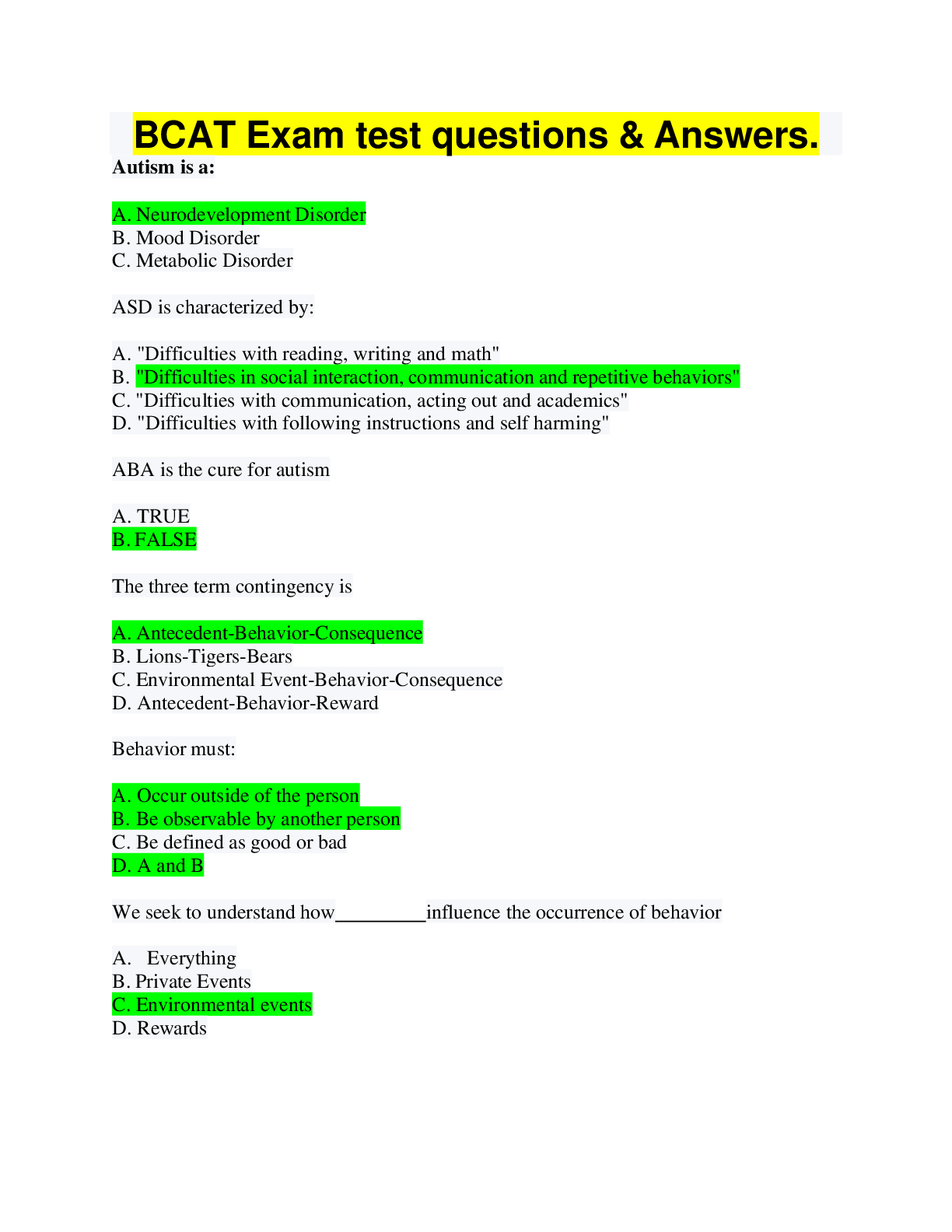
Reviews( 0 )
Document information
Connected school, study & course
About the document
Uploaded On
May 31, 2022
Number of pages
25
Written in
Additional information
This document has been written for:
Uploaded
May 31, 2022
Downloads
0
Views
33




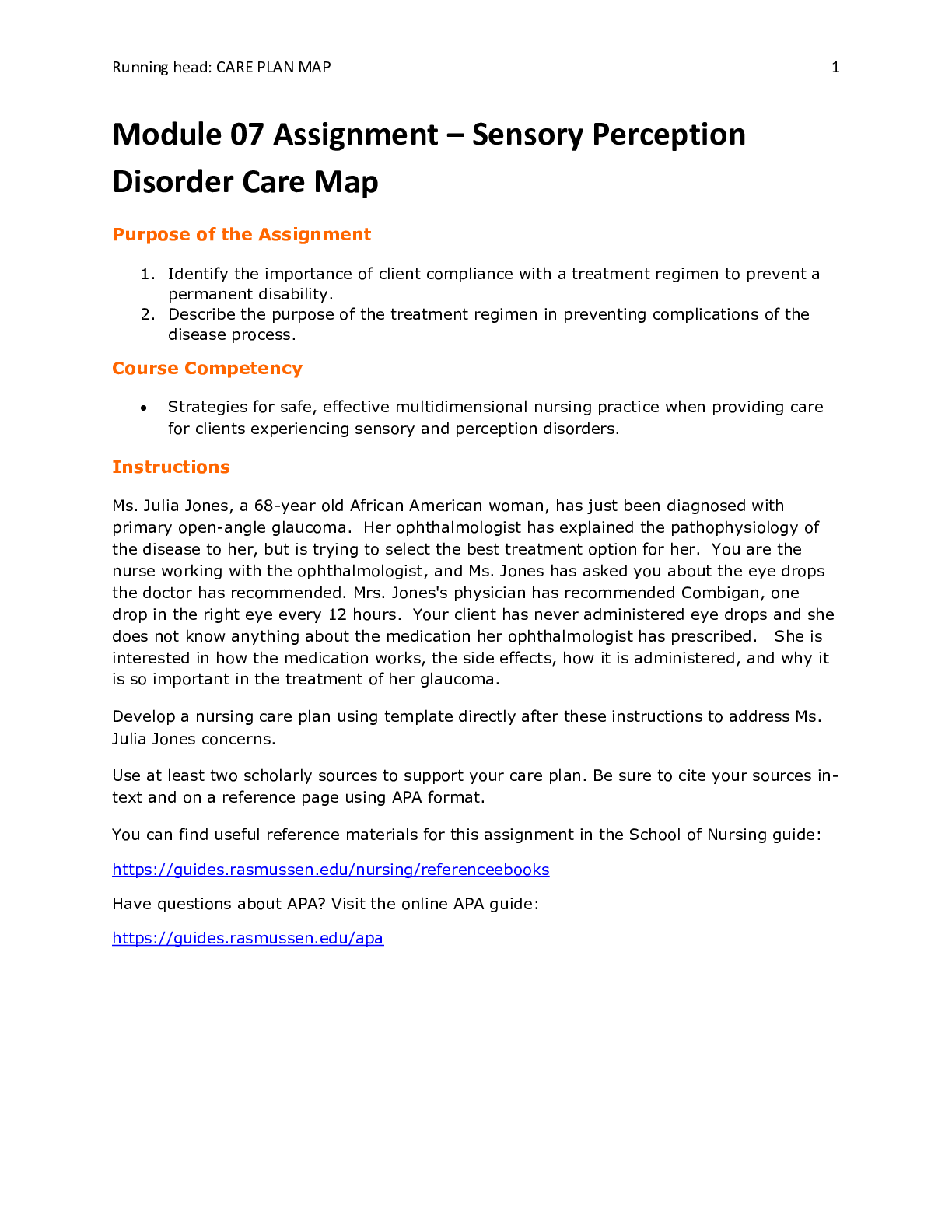
.png)


